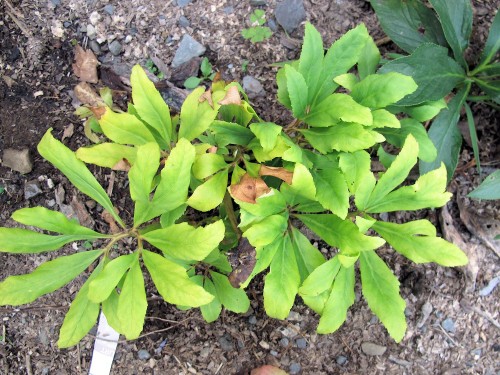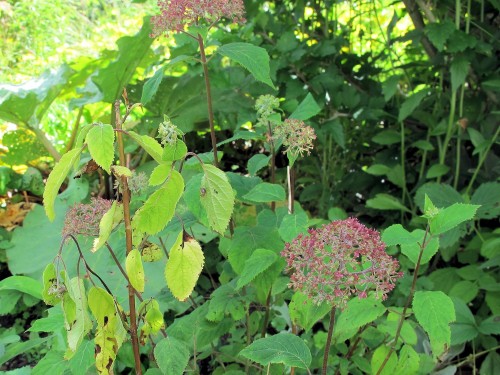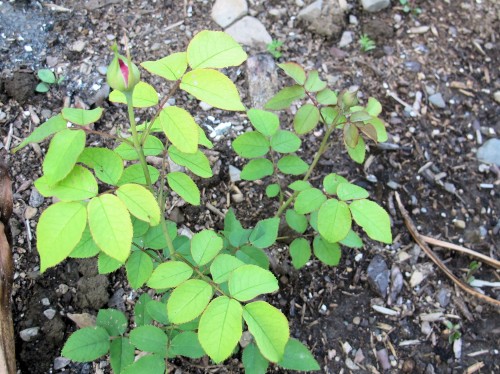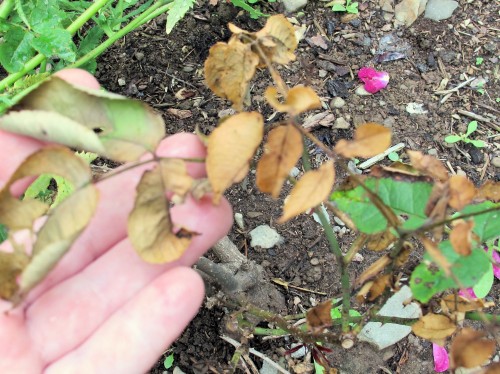A lot of my plants have yellow leaves that aren’t supposed to. It’s been raining frequently–often heavy downpours–and when it hasn’t been raining it’s been quite humid. So both the air and the soil are saturated–a recipe for plant disease if the plants aren’t adapted to those conditions. Here’s what I’ve been seeing:
Can This Plant Be Saved?
Why is this ‘Josef Lemper’ hellebore (Helleborus niger ‘HGC Josef Lemper’) pictured above turning yellow, when the one right next to it is deep green? To me, those leaves look like a sign of nutrient deficiency, except that the hellebore right next to it looks fine. So I wonder if the roots are rotting. I also see brown areas on the yellow leaves, which makes me fear that the whole plant will die soon. At Plant Delights Nursery they say that “well-drained soils are very important for success with Helleborus niger.” So maybe it is root rot. This is one of my favorite hellebores because it blooms in November and December before being buried in snow, and then picks up where it left off when the snow melts. I brought it over from my old garden earlier this spring and it appeared healthy and bloomed well, and the other H. nigers that I have still look dark green. Can this plant be saved (she asks, wringing her hands)?
One Stem–So Far
Unlike the hellebore, this Bella Anna® hydrangea (Hydrangea arborescens ‘PIIHA-I’) only has one stem with yellow leaves. So far. But like the hellebore, the yellow leaves also show brown spots and patches. When it’s only one part of the plant, I don’t think it’s a nutrient deficiency. It’s more likely disease, though it still could be root rot, I suppose. (Which is a symptom of disease, when you think about it.) Sigh. I should probably prune this stem off, don’t you think?New Growth–Or Sick Growth?
If I weren’t paranoid about yellowing leaves by now, I would look at this William Shakespeare 2000® rose (Rosa ‘Ausromeo’) and think the leaves were paler because they were new growth and would green up within a week. But now, I’m not so sure. Especially since the Darcy Bussell rose (Rosa ‘Ausdecorum’) across the walk has had the leaves on a whole branch turn brown–and I can’t remember if they were yellow first.
The brown leaves also showed up on the one and only branch that made it through the winter of a different rose, which has since been pulled up and replaced.What’s Up With These Yellow Leaves?
Different plants, different locations in the garden–it could easily be three different problems. I’ve tried googling without much success, so if you have any information to add, please contribute it in the comments. I think I will cut that one stem off the hydrangea, keep my eye on the rose, and wail and gnash my teeth over the hellebore–and scout out a source for a new one. What would you do?








Today’s newsletter from the Rensselaer/Albany Cornell Co-op Extension had this to say about yellowing leaves in the writer’s vegetable garden: “Many of the crops look a little yellow. My fertility was in line when these crops were planted. The pH and organic level were also in range. So, where did my N-P- K go? Down. These elements must go into a water-solution for the plants to use. With all this rain, my fertilizer is in the sub-soil. But the roots are shallow. Roots don’t reach for fertilizer; they reach for water. A side dressing of 5-3-4 organic is necessary NOW. The broccoli and cauliflower are only 10 days away from harvest. Foliar feeding is the only way to help here.”
Thanks. That’s confirmation of what I was suspecting.
I’m having heavy rains here in Ohio, too. I hate to say it, but when I have had a plant look sickly like your hellebore, it was lost. Usually some kind of rot hit the crown.
The roses usually recover with pruning.
Hope your plants recover!
I have had the same problems on many plants, especially roses. I lost a hellebore and a few other plants from all the wet this year. Hopefully the torrential rains will stop soon and the plats will recover!
I alos think it is the torrential rains…even some of my grow bags and containers are not happy with this rain.
Is it Chlorosis? It is usually caused by environmental or nutrient problems. You might have a high PH soil if it’s widespread. Plant may die if this condition worsens. Find out first the real cause before treating it.
Lenny 🙂
The horrendous weather extremes, temps, and rain and grey sunless days are as never before.
The result for me is the greenest and happiest gardens ever. I suppose that its being hilly and my sloppy method of creating drainage by making the woodland gardens by putting layers of composted leaves from the town dump, peat moss, and using wood chip mulches helps a great deal. I put about six inches of the first two on top of the gritty root and rootlet “soil” and turn all over at a shovels depth when that original layer is good and damp from rains or sprinkles going. I often had to use a mattock but I am getting beyond that..sigh. It is a wonder I have not permanently ruined the rototiller.
I feel quite certain that your leaves are showing stress from lack of drainage, key ingredients having leached out, or lacking a healthy chlorophyl making system, but I suspect all should recover. One other possibility could be a poison of some worth, but I think that unlikely unless someone uses Round Up carelessly.
You will need to take care, though, when we will undoubtedly get drought, that any dry areas get deep watering once in a while.
I do find that some of my nigers, both from mature and seedling plants are rather persnickety but once they get going in two to three years they make the leaves of the oriental is varieties look very common…smile. Hope the breeders continue to work on getting blossoms in colors and heavier bloom. I bought several of the
German Gold series as decorative plants in Dec. They were huge and were going at 9.95! They lasted weeks but were dreadfully under potted and I am not sure they will recover in the gardens.
Best of luck,
Marcia
I’d pot up the hellebore so that it got better drainage. If it’s that wet, you might be able to leave the pot in that area.
Do you have a place with better drainage to move it to if it recovers in the pot?
That’s the thing–it doesn’t appear to be poorly drained there. At least, not any more poorly drained than the hellebore right next to it. Clay soil, amended with composted manure (but probably not enough amendment) is what they are both growing in.
In addition to all the rain, we have a leak somewhere in the line that brings spring water down the hill to the yard spigots and the outdoor sink. It’s flooding the yard down below the house. I rescued a couple enormous daylilies that were sitting in the middle of this new ‘bog’, but I think my clematis in that spot is already dead and a couple other things to big to move look stressed. Yellowing leaves like in your pic.
I’d dig up the Hellebore to see what’s going on with the roots. I had some planted in a soggy area and was able to save a few by digging them up and re-planting them. You’d probably have to plant them in a pot with fresh potting soil until the ground dries out though. As for the Hydrangea, I’d check for borers. I’ve had this nasty insect affect anything that is crowded and stressed from peonies to lilies, hydrangea… just about anything. Cut the stem as close to the ground as possible and cut sections up to the top to see if it’s hollow.
Thanks, Jean. I am thinking about digging the hellebore up to see what’s what. And I’ll see to the hydrangea.
Same here in northern Vermont; and many leaves on apple trees are also turning yellow, and dropping off. I have read that heavy rain – torrential, as we’ve been getting – does two things; it leaches nutrients from the soil, and it compacts the soil so that smaller feeder roots can’t form, depriving the plant further of nutrients.
I’m seeing some of the same things here in my 2 year old southern Vermont garden. I think I have pockets of good soil and pockets of poor drainage. I’m doing just what you are doing plus dousing liberally with fish emulsion…just in case there is actually a fertility issue. Almost 7 inches of rain here in last 10 days. And Josef Lemper has yellowed completely. It is a new plant, so I am hoping for healthy foliage in fall???
It’s some comfort to learn I’m not the only one. We can hope for new foliage, but we may need to replace our plants. I love ‘Josef Lemper’ enough to want to try him again. I would add more organic matter if I had to replant. But as I said to Gail, I am tempted to dig him up to see what is going on–but I am going to wait for this heat wave to pass before I do so.
I’ve been getting some yellow leaves as well. This area has had some torrential rain storms in the last month. I’m kinda holding off doing anything to see if it’s a weather oddity. How can you change drainage if climate change persists?
You can change drainage in an isolated bed by adding grit, but you can’t change your soil wholesale unless you are very rich. Instead, as plants die, you replant with better-adapted ones. But one year with heavy rain does not constitute climate change, just as the mild winter of 2011-2012 didn’t. But if you meant by climate change an erratic climate that’s not consistent, we are moving into uncharted territory. I am glad I don’t make my living growing plants.
I hope you can figure it all out Kathy. I noticed a plant with similar symptoms and when I dug it up, I discovered a large hunk of limestone hiding under soil directly under the one plant. it was messing with the drainage. gail
I am considering digging up Josef Lemper to see what’s what. I had a rose almost die once because rodents were tunneling under the roots.
That is very worrisome, Kathy. Definitely remove the hydrangea stem and just watch the others. It looks like drainage issues to me. H. niger won’t grow in my acidic garden, does better with alkaline soil, I read. I hope you can get it figured out!
This same plant was doing well in the acid soil of my previous garden. But the soil of that garden had more organic matter. Yet, there are other nigers in the same area and they are doing fine.
I usually see this on many of my plants in the early spring when it is too cold. they usually make a recovery when the temps rise. However, hellebores are really spring plants so not sure why this is. I know in England they remove all the old leaves when the blooms come but these may be new leaves.
The yellow leaves are certainly a sign of stress. The weather has given us all fits over the past several years. Too cold, too rainy, or not enough rain at the right time have all led to plant losses. I haven’t lost a lot of plants, but the ones I have, have been a surprise. I would tell you to not give up on anything too soon.